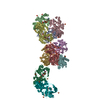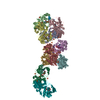[English] 日本語
 Yorodumi
Yorodumi- EMDB-2418: Structure and activity of an RNA-targeting Type III-B CRISPER-Cas... -
+ Open data
Open data
- Basic information
Basic information
| Entry | Database: EMDB / ID: EMD-2418 | |||||||||
|---|---|---|---|---|---|---|---|---|---|---|
| Title | Structure and activity of an RNA-targeting Type III-B CRISPER-Cas complex | |||||||||
 Map data Map data | Reconstruction of Type III-B CRISPR-Cas complex from Thermus thermophilus | |||||||||
 Sample Sample |
| |||||||||
 Keywords Keywords |  CRISPR-Cas / RNA-targeting / Cmr complex CRISPR-Cas / RNA-targeting / Cmr complex | |||||||||
| Function / homology |  Function and homology information Function and homology informationregulation of defense response to virus / defense response to virus /  cytoplasm cytoplasmSimilarity search - Function | |||||||||
| Biological species |    Thermus thermophilus (bacteria) Thermus thermophilus (bacteria) | |||||||||
| Method |  single particle reconstruction / single particle reconstruction /  negative staining / Resolution: 22.0 Å negative staining / Resolution: 22.0 Å | |||||||||
 Authors Authors | Staals RHJ / Agari Y / Maki-Yonekura S / Zhu Y / Taylor DW / van Duijn E / Barendregt A / Vlot M / Koehorst JJ / Sakamoto K ...Staals RHJ / Agari Y / Maki-Yonekura S / Zhu Y / Taylor DW / van Duijn E / Barendregt A / Vlot M / Koehorst JJ / Sakamoto K / Masuda A / Dohmae N / Schaap PJ / Doudna JA / Heck AJ / Yonekura K / van der Oost J / Shinkai A | |||||||||
 Citation Citation |  Journal: Mol Cell / Year: 2013 Journal: Mol Cell / Year: 2013Title: Structure and activity of the RNA-targeting Type III-B CRISPR-Cas complex of Thermus thermophilus. Authors: Raymond H J Staals / Yoshihiro Agari / Saori Maki-Yonekura / Yifan Zhu / David W Taylor / Esther van Duijn / Arjan Barendregt / Marnix Vlot / Jasper J Koehorst / Keiko Sakamoto / Akiko ...Authors: Raymond H J Staals / Yoshihiro Agari / Saori Maki-Yonekura / Yifan Zhu / David W Taylor / Esther van Duijn / Arjan Barendregt / Marnix Vlot / Jasper J Koehorst / Keiko Sakamoto / Akiko Masuda / Naoshi Dohmae / Peter J Schaap / Jennifer A Doudna / Albert J R Heck / Koji Yonekura / John van der Oost / Akeo Shinkai /    Abstract: The CRISPR-Cas system is a prokaryotic host defense system against genetic elements. The Type III-B CRISPR-Cas system of the bacterium Thermus thermophilus, the TtCmr complex, is composed of six ...The CRISPR-Cas system is a prokaryotic host defense system against genetic elements. The Type III-B CRISPR-Cas system of the bacterium Thermus thermophilus, the TtCmr complex, is composed of six different protein subunits (Cmr1-6) and one crRNA with a stoichiometry of Cmr112131445361:crRNA1. The TtCmr complex copurifies with crRNA species of 40 and 46 nt, originating from a distinct subset of CRISPR loci and spacers. The TtCmr complex cleaves the target RNA at multiple sites with 6 nt intervals via a 5' ruler mechanism. Electron microscopy revealed that the structure of TtCmr resembles a "sea worm" and is composed of a Cmr2-3 heterodimer "tail," a helical backbone of Cmr4 subunits capped by Cmr5 subunits, and a curled "head" containing Cmr1 and Cmr6. Despite having a backbone of only four Cmr4 subunits and being both longer and narrower, the overall architecture of TtCmr resembles that of Type I Cascade complexes. | |||||||||
| History |
|
- Structure visualization
Structure visualization
| Movie |
 Movie viewer Movie viewer |
|---|---|
| Structure viewer | EM map:  SurfView SurfView Molmil Molmil Jmol/JSmol Jmol/JSmol |
| Supplemental images |
- Downloads & links
Downloads & links
-EMDB archive
| Map data |  emd_2418.map.gz emd_2418.map.gz | 10.7 MB |  EMDB map data format EMDB map data format | |
|---|---|---|---|---|
| Header (meta data) |  emd-2418-v30.xml emd-2418-v30.xml emd-2418.xml emd-2418.xml | 15 KB 15 KB | Display Display |  EMDB header EMDB header |
| Images |  emd_2418.tif emd_2418.tif | 881 KB | ||
| Archive directory |  http://ftp.pdbj.org/pub/emdb/structures/EMD-2418 http://ftp.pdbj.org/pub/emdb/structures/EMD-2418 ftp://ftp.pdbj.org/pub/emdb/structures/EMD-2418 ftp://ftp.pdbj.org/pub/emdb/structures/EMD-2418 | HTTPS FTP |
-Related structure data
- Links
Links
| EMDB pages |  EMDB (EBI/PDBe) / EMDB (EBI/PDBe) /  EMDataResource EMDataResource |
|---|
- Map
Map
| File |  Download / File: emd_2418.map.gz / Format: CCP4 / Size: 11.1 MB / Type: IMAGE STORED AS FLOATING POINT NUMBER (4 BYTES) Download / File: emd_2418.map.gz / Format: CCP4 / Size: 11.1 MB / Type: IMAGE STORED AS FLOATING POINT NUMBER (4 BYTES) | ||||||||||||||||||||||||||||||||||||||||||||||||||||||||||||||||||||
|---|---|---|---|---|---|---|---|---|---|---|---|---|---|---|---|---|---|---|---|---|---|---|---|---|---|---|---|---|---|---|---|---|---|---|---|---|---|---|---|---|---|---|---|---|---|---|---|---|---|---|---|---|---|---|---|---|---|---|---|---|---|---|---|---|---|---|---|---|---|
| Annotation | Reconstruction of Type III-B CRISPR-Cas complex from Thermus thermophilus | ||||||||||||||||||||||||||||||||||||||||||||||||||||||||||||||||||||
| Voxel size | X=Y=Z: 2.8 Å | ||||||||||||||||||||||||||||||||||||||||||||||||||||||||||||||||||||
| Density |
| ||||||||||||||||||||||||||||||||||||||||||||||||||||||||||||||||||||
| Symmetry | Space group: 1 | ||||||||||||||||||||||||||||||||||||||||||||||||||||||||||||||||||||
| Details | EMDB XML:
CCP4 map header:
| ||||||||||||||||||||||||||||||||||||||||||||||||||||||||||||||||||||
-Supplemental data
- Sample components
Sample components
-Entire : Type III-B CRISPR-Cas complex of Thermus thermophilus
| Entire | Name: Type III-B CRISPR-Cas complex of Thermus thermophilus |
|---|---|
| Components |
|
-Supramolecule #1000: Type III-B CRISPR-Cas complex of Thermus thermophilus
| Supramolecule | Name: Type III-B CRISPR-Cas complex of Thermus thermophilus / type: sample / ID: 1000 / Number unique components: 12 |
|---|---|
| Molecular weight | Experimental: 365 KDa / Method: MS/MS |
-Macromolecule #1: CRISPR-associated protein TM1791
| Macromolecule | Name: CRISPR-associated protein TM1791 / type: protein_or_peptide / ID: 1 / Name.synonym: Cmr6, TTHB165 / Number of copies: 1 / Recombinant expression: No |
|---|---|
| Source (natural) | Organism:    Thermus thermophilus (bacteria) Thermus thermophilus (bacteria) |
| Molecular weight | Experimental: 38 KDa / Theoretical: 38 KDa |
| Sequence | UniProtKB: Type III-B CRISPR module RAMP protein Cmr6 / InterPro: CRISPR-associated protein, TM1791 |
-Macromolecule #3: CRISPR system Cmr subunit Cmr5
| Macromolecule | Name: CRISPR system Cmr subunit Cmr5 / type: protein_or_peptide / ID: 3 Name.synonym: Cmr5, CRISPR type III-B/RAMP module-associated protein Cmr5 Number of copies: 3 / Recombinant expression: No |
|---|---|
| Source (natural) | Organism:    Thermus thermophilus (bacteria) Thermus thermophilus (bacteria) |
| Molecular weight | Experimental: 12 KDa / Theoretical: 12 KDa |
| Sequence | UniProtKB: CRISPR system Cmr subunit Cmr5 / GO: regulation of defense response to virus / InterPro: CRISPR-associated protein, Cmr5 |
-Macromolecule #4: CRISPR-associated protein Cmr3
| Macromolecule | Name: CRISPR-associated protein Cmr3 / type: protein_or_peptide / ID: 4 / Name.synonym: Cmr3, TTHB160 / Number of copies: 1 / Recombinant expression: No |
|---|---|
| Source (natural) | Organism:    Thermus thermophilus (bacteria) Thermus thermophilus (bacteria) |
| Molecular weight | Experimental: 39 KDa / Theoretical: 39 KDa |
| Sequence | UniProtKB: CRISPR-associated protein Cmr3 / InterPro: CRISPR-associated protein, Cmr3 |
-Macromolecule #5: CRISPR-associated protein Crm2
| Macromolecule | Name: CRISPR-associated protein Crm2 / type: protein_or_peptide / ID: 5 / Name.synonym: Cmr2, TTHB160 / Number of copies: 1 / Recombinant expression: No |
|---|---|
| Source (natural) | Organism:    Thermus thermophilus (bacteria) Thermus thermophilus (bacteria) |
| Molecular weight | Experimental: 65 KDa / Theoretical: 65 KDa |
| Sequence | UniProtKB: GGDEF domain-containing protein / InterPro: CRISPR-associated protein Cmr2 |
-Macromolecule #6: CRISPR-associated RAMP Cmr4
| Macromolecule | Name: CRISPR-associated RAMP Cmr4 / type: protein_or_peptide / ID: 6 / Name.synonym: Cmr4, TTHB163 / Number of copies: 4 / Recombinant expression: No |
|---|---|
| Source (natural) | Organism:    Thermus thermophilus (bacteria) Thermus thermophilus (bacteria) |
| Molecular weight | Experimental: 37 KDa / Theoretical: 37 KDa |
| Sequence | UniProtKB: Type III-B CRISPR module RAMP protein Cmr4 / InterPro: CRISPR-associated RAMP Cmr4 |
-Macromolecule #7: CRISPR-associated protein TM1795
| Macromolecule | Name: CRISPR-associated protein TM1795 / type: protein_or_peptide / ID: 7 / Name.synonym: Cmr1, TTHB162 / Number of copies: 1 / Recombinant expression: No |
|---|---|
| Source (natural) | Organism:    Thermus thermophilus (bacteria) Thermus thermophilus (bacteria) |
| Molecular weight | Experimental: 44 KDa |
| Sequence | UniProtKB: Type III-B CRISPR module RAMP protein Cmr1 / InterPro: CRISPR-associated protein TM1795 |
-Macromolecule #2: CRISPR RNA
| Macromolecule | Name: CRISPR RNA / type: rna / ID: 2 / Name.synonym: crRNA / Details: 40-46 nucleotide endogenous crRNA bound to complex / Classification: OTHER / Structure: SINGLE STRANDED / Synthetic?: No |
|---|---|
| Source (natural) | Organism:    Thermus thermophilus (bacteria) Thermus thermophilus (bacteria) |
-Experimental details
-Structure determination
| Method |  negative staining negative staining |
|---|---|
 Processing Processing |  single particle reconstruction single particle reconstruction |
| Aggregation state | particle |
- Sample preparation
Sample preparation
| Concentration | 0.03 mg/mL |
|---|---|
| Buffer | pH: 7.4 Details: 25 mM Hepes, pH 7.5, 100 mM KCl, 1 mM TCEP, 5% glycerol |
| Staining | Type: NEGATIVE Details: Sample applied to glow-discharged continuous carbon grids. After 1 min, grids were stained consecutively in 6 droplets of 2% (w/v) uranyl acetate solution and excess stain removed by gentle ...Details: Sample applied to glow-discharged continuous carbon grids. After 1 min, grids were stained consecutively in 6 droplets of 2% (w/v) uranyl acetate solution and excess stain removed by gentle blotting with filter paper. |
| Grid | Details: 200 mesh Cu grid |
| Vitrification | Cryogen name: NONE / Instrument: OTHER |
- Electron microscopy
Electron microscopy
| Microscope | FEI TECNAI 20 |
|---|---|
| Electron beam | Acceleration voltage: 120 kV / Electron source:  FIELD EMISSION GUN FIELD EMISSION GUN |
| Electron optics | Illumination mode: FLOOD BEAM / Imaging mode: BRIGHT FIELD Bright-field microscopy / Cs: 2.2 mm / Nominal defocus max: -1.4 µm / Nominal defocus min: -0.5 µm / Nominal magnification: 80000 Bright-field microscopy / Cs: 2.2 mm / Nominal defocus max: -1.4 µm / Nominal defocus min: -0.5 µm / Nominal magnification: 80000 |
| Sample stage | Specimen holder model: OTHER |
| Alignment procedure | Legacy - Astigmatism: Objective astigmatism was corrected at 210,000 times magnification |
| Details | Data acquired using Leginon |
| Date | Jan 29, 2013 |
| Image recording | Category: CCD / Film or detector model: GENERIC GATAN (4k x 4k) / Number real images: 300 / Average electron dose: 20 e/Å2 |
- Image processing
Image processing
| CTF correction | Details: ACE2 micrograph |
|---|---|
| Final reconstruction | Applied symmetry - Point group: C1 (asymmetric) / Algorithm: OTHER / Resolution.type: BY AUTHOR / Resolution: 22.0 Å / Resolution method: FSC 0.5 CUT-OFF / Software - Name: EMAN2, SPARX / Number images used: 45000 |
 Movie
Movie Controller
Controller











